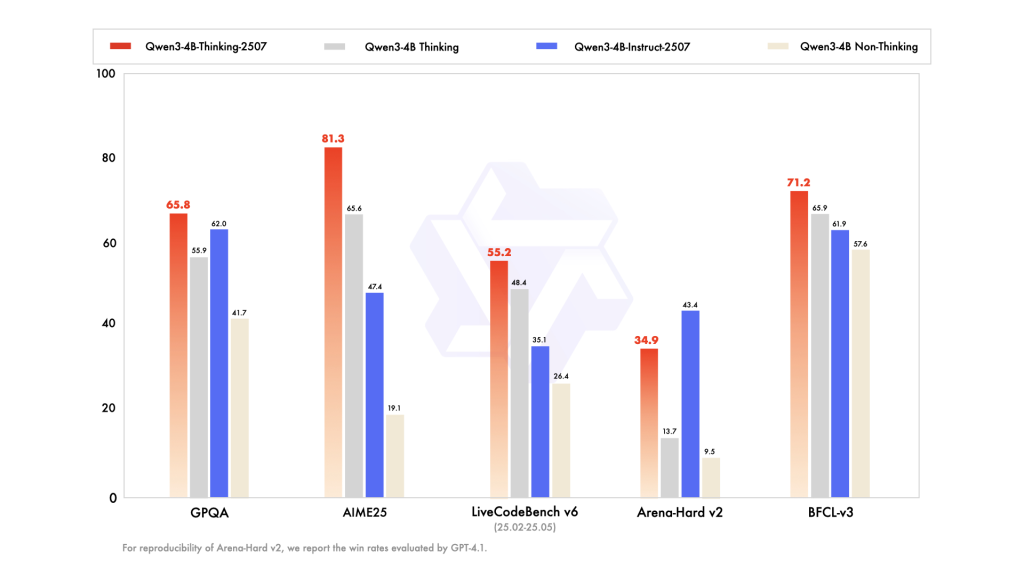Alibaba Qwen Unveils Qwen3-4B-Instruct-2507 and Qwen3-4B-Thinking-2507: Refreshing the Importance of Small Language Models
Smaller Models with Smarter Performance and 256K Context Support Alibaba’s Qwen team has introduced two powerful additions to its small language model lineup: Qwen3-4B-Instruct-2507 and Qwen3-4B-Thinking-2507. Despite having only 4 billion parameters, these models deliver exceptional capabilities across general-purpose and expert-level tasks while running efficiently on consumer-grade hardware. Both are designed with native 256K token context windows, meaning they can process extremely long inputs such as large codebases, multi-document archives, and extended dialogues without external modifications. Architecture and Core Design Both models feature 4 billion total parameters (3.6B excluding embeddings) built across 36 transformer layers. They use Grouped Query Attention (GQA) with 32 query heads and 8 key/value heads, enhancing efficiency and memory management for very large contexts. They are dense transformer architectures—not mixture-of-experts—which ensures consistent task performance. Long-context support up to 262,144 tokens is baked directly into the model architecture, and each model is pretrained extensively before undergoing alignment and safety post-training to ensure responsible, high-quality outputs. Qwen3-4B-Instruct-2507 — A Multilingual, Instruction-Following Generalist The Qwen3-4B-Instruct-2507 model is optimized for speed, clarity, and user-aligned instruction following. It is designed to deliver direct answers without explicit step-by-step reasoning, making it perfect for scenarios where users want concise responses rather than detailed thought processes. Multilingual coverage spans over 100 languages, making it highly suitable for global deployments in chatbots, customer support, education, and cross-language search. Its native 256K context support enables it to handle tasks like analyzing large legal documents, processing multi-hour transcripts, or summarizing massive datasets without splitting the content. Performance Benchmarks: Benchmark Task Score General Knowledge (MMLU-Pro) 69.6 Reasoning (AIME25) 47.4 SuperGPQA (QA) 42.8 Coding (LiveCodeBench) 35.1 Creative Writing 83.5 Multilingual Comprehension (MultiIF) 69.0 In practice, this means Qwen3-4B-Instruct-2507 can handle everything from language tutoring in multiple languages to generating rich narrative content, while still providing competent performance in reasoning, coding, and domain-specific knowledge. Qwen3-4B-Thinking-2507 — Expert-Level Chain-of-Thought Reasoning Where the Instruct model focuses on concise responsiveness, the Qwen3-4B-Thinking-2507 model is engineered for deep reasoning and problem-solving. It automatically generates explicit chains of thought in its outputs, making its decision-making process transparent—especially beneficial for complex domains like mathematics, science, and programming. This model excels at technical diagnostics, scientific data interpretation, and multi-step logical analysis. It’s suited for advanced AI agents, research assistants, and coding companions that need to reason through problems before answering. Performance Benchmarks: Benchmark Task Score Math (AIME25) 81.3% Science (HMMT25) 55.5% General QA (GPQA) 65.8% Coding (LiveCodeBench) 55.2% Tool Usage (BFCL) 71.2% Human Alignment 87.4% These scores demonstrate that Qwen3-4B-Thinking-2507 can match or even surpass much larger models in reasoning-heavy benchmarks, allowing more accurate and explainable results for mission-critical use cases. Across Both Models Both the Instruct and Thinking variants share key advancements. The 256K native context window allows for seamless work on extremely long inputs without external memory hacks. They also feature improved alignment, producing more natural, coherent, and context-aware responses in creative and multi-turn conversations. Furthermore, both are agent-ready, supporting API calling, multi-step reasoning, and workflow orchestration out-of-the-box. From a deployment perspective, they are highly efficient—capable of running on mainstream consumer GPUs with quantization for lower memory usage, and fully compatible with modern inference frameworks. This means developers can run them locally or scale them in cloud environments without significant resource investment. Practical Deployment and Applications Deployment is straightforward, with broad framework compatibility enabling integration into any modern ML pipeline. They can be used in edge devices, enterprise virtual assistants, research institutions, coding environments, and creative studios. Example scenarios include: Instruction-Following Mode: Customer support bots, multilingual educational assistants, real-time content generation. Thinking Mode: Scientific research analysis, legal reasoning, advanced coding tools, and agentic automation. Conclusion The Qwen3-4B-Instruct-2507 and Qwen3-4B-Thinking-2507 prove that small language models can rival and even outperform larger models in specific domains when engineered thoughtfully. Their blend of long-context handling, strong multilingual capabilities, deep reasoning (in Thinking mode), and alignment improvements makes them powerful tools for both everyday and specialist AI applications. With these releases, Alibaba has set a new benchmark in making 256K-ready, high-performance AI models accessible to developers worldwide. Check out the Qwen3-4B-Instruct-2507 Model and Qwen3-4B-Thinking-2507 Model. Feel free to check out our GitHub Page for Tutorials, Codes and Notebooks. Also, feel free to follow us on Twitter and don’t forget to Subscribe to our Newsletter. Discuss on Hacker News Join our ML Subreddit Sponsor us The post Alibaba Qwen Unveils Qwen3-4B-Instruct-2507 and Qwen3-4B-Thinking-2507: Refreshing the Importance of Small Language Models appeared first on MarkTechPost.


